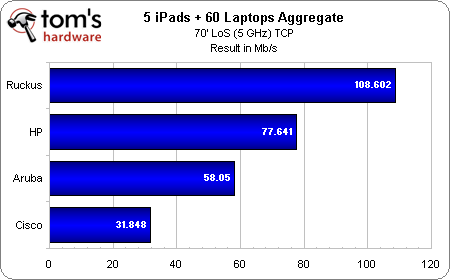Why Your Wi-Fi Sucks And How It Can Be Helped, Part 2
In Part 1, we explained what can go wrong with Wi-Fi signals and how access points can work to improve your wireless performance. It's time for a reality check. We throw six contenders against 65 clients and some hellish interference. Who's left standing?
Mid-Range, iPads And Laptops Aggregate
We already know that Apple and Meraki collapse under 60 clients, but for the remaining contenders, what happens when you bring another five iPad 2 tablets into the mix? For one thing, HP seems to hold up surprisingly well. While the HP disappointed in our interference testing, it seems revitalized when it comes to handling massive traffic loads...or does it?
When we break out the data for laptops versus iPad 2s, a different story appears. Recall from our single laptop versus iPad comparison how the laptop’s throughput was roughly 7.5x greater than that of the tablet. Yet we have 12 times as many laptops as tablets. What should be the proper ratio of notebook to tablet bandwidth in this test—7.5x, 12x, or somewhere in between? There may be no perfect answer, but it’s safe to assume that somewhere in the middle is best. Ruckus and Cisco both land in this zone, showing notebook throughput of about 11x and 9x that of the five attached tablets. HP, however, comes in with nearly 60x, starving the iPads with only a trickle of data. Not much airtime fairness there.
Aruba goes in the opposite direction, giving the iPads far more time than they deserve—over one-third of the total bandwidth. Given this, perhaps it should come as no surprise that Aruba disabled airtime fairness by default. We can only assume that this is a gross oversight on Aruba’s part, but our mission to only use default AP settings before starting testing was clear. Regardless, this highlights the importance of airtime fairness in a crowded Wi-Fi environment with mixed device types.
Get Tom's Hardware's best news and in-depth reviews, straight to your inbox.
Current page: Mid-Range, iPads And Laptops Aggregate
Prev Page Five iPad 2s: Single And Aggregate Performance Next Page Airtime Fairness Under Pressure-
winner4455 Hey, I still haven't read this article but right away I notice the new format. Just thanking you for listening to your readers! :)Reply -
cangelini Very welcome Winner. We thought the picture story format would work for that last part and didn't realize the text would come out to be so terrible. From now on, we'll only use picture stories when the captions fit without requiring another click!Reply -
tacoslave cangeliniVery welcome Winner. We thought the picture story format would work for that last part and didn't realize the text would come out to be so terrible. From now on, we'll only use picture stories when the captions fit without requiring another click!"Now thats what i like to hear!"Reply -
nekromobo What if you add few thin-foil balls to room (the size of fist or 2)Reply
That should add few rf-reflections or paths, right?
Just your 2cent amplifier.. :) -
I wonder why you didn't include Juniper products (formerly trapeze)to this test. It's quit a big player here in europe. Trapeze also produced the 3com wireless manager and accesspoints which was sold widely here.Reply
-
Hupiscratch In the page "Benchmark Results: Close Range, No Interference", the HP AP is missing on the downlink graph.Reply -
Onus This was an outstanding article. Going just by this, Ruckus and Cisco are the only two I'd consider out of the box, but it would be very interesting to do a follow on that features even a minimal amount of tweaking to see what changes. A consumer expects a product to work well out of the box, but an enterprise network engineer almost certainly does not.Reply
-
Very thorough. Lots of hard work went into this and it shows. But how did you select client devices? Did you try any other chipsets? We tried something like this with more diverse clients and got results that were too variable to reach conclusions. (Some clients just did better with some APs than others.)Reply

